Significance of He Whakaputanga/1835 Declaration of Independence
VerifiedAdded on 2022/08/23
|10
|2397
|21
AI Summary
Contribute Materials
Your contribution can guide someone’s learning journey. Share your
documents today.
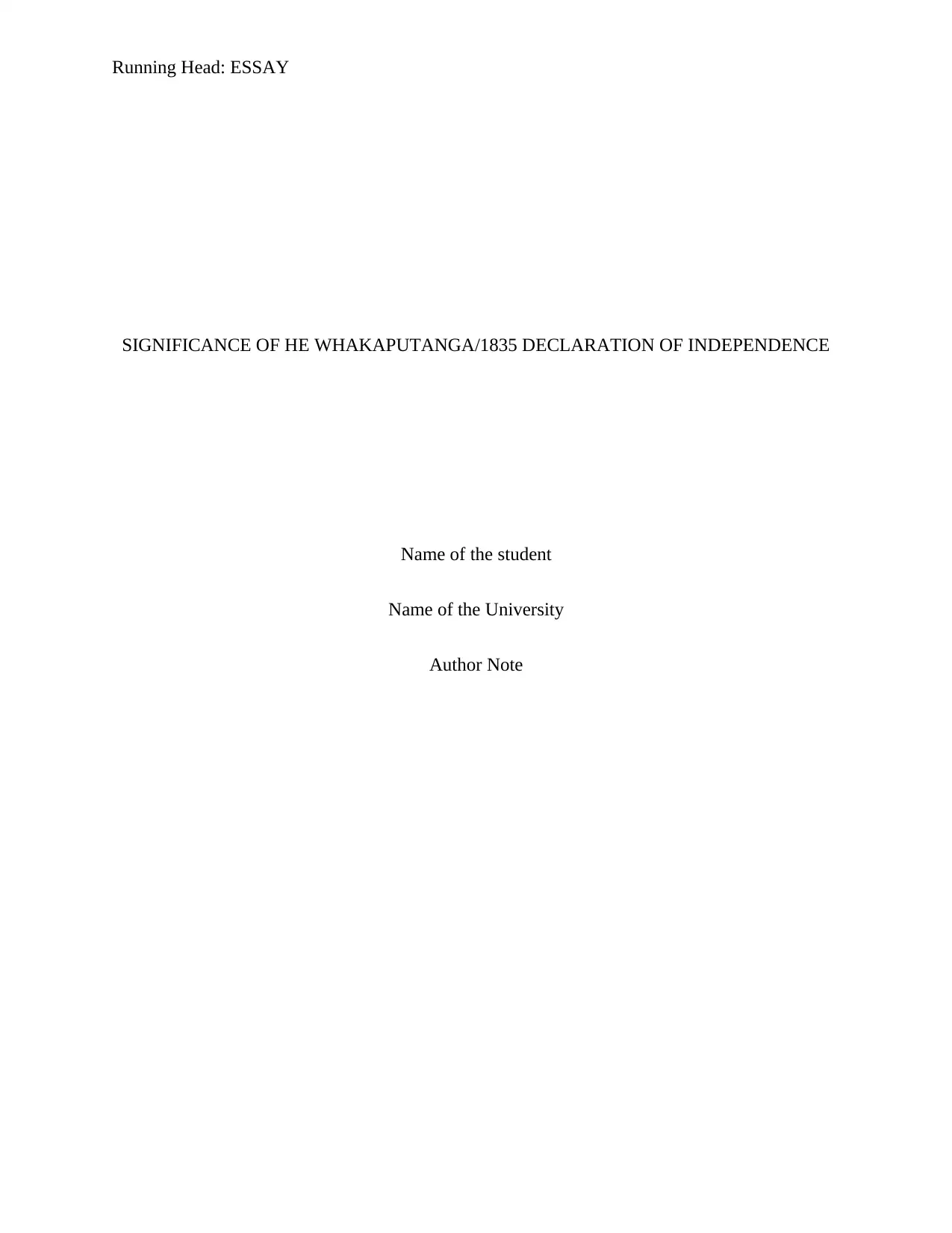
Running Head: ESSAY
SIGNIFICANCE OF HE WHAKAPUTANGA/1835 DECLARATION OF INDEPENDENCE
Name of the student
Name of the University
Author Note
SIGNIFICANCE OF HE WHAKAPUTANGA/1835 DECLARATION OF INDEPENDENCE
Name of the student
Name of the University
Author Note
Secure Best Marks with AI Grader
Need help grading? Try our AI Grader for instant feedback on your assignments.
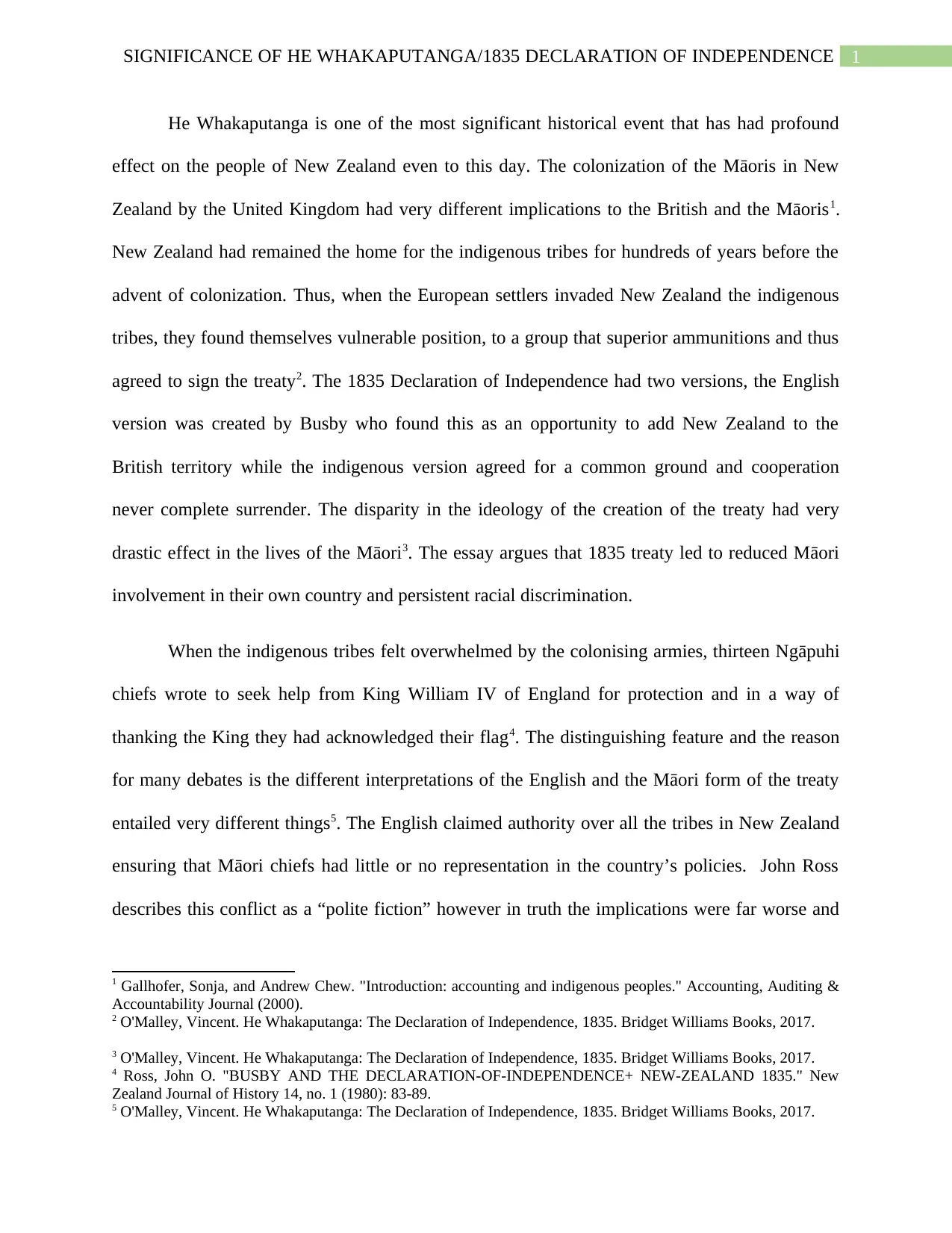
1SIGNIFICANCE OF HE WHAKAPUTANGA/1835 DECLARATION OF INDEPENDENCE
He Whakaputanga is one of the most significant historical event that has had profound
effect on the people of New Zealand even to this day. The colonization of the Māoris in New
Zealand by the United Kingdom had very different implications to the British and the Māoris1.
New Zealand had remained the home for the indigenous tribes for hundreds of years before the
advent of colonization. Thus, when the European settlers invaded New Zealand the indigenous
tribes, they found themselves vulnerable position, to a group that superior ammunitions and thus
agreed to sign the treaty2. The 1835 Declaration of Independence had two versions, the English
version was created by Busby who found this as an opportunity to add New Zealand to the
British territory while the indigenous version agreed for a common ground and cooperation
never complete surrender. The disparity in the ideology of the creation of the treaty had very
drastic effect in the lives of the Māori3. The essay argues that 1835 treaty led to reduced Māori
involvement in their own country and persistent racial discrimination.
When the indigenous tribes felt overwhelmed by the colonising armies, thirteen Ngāpuhi
chiefs wrote to seek help from King William IV of England for protection and in a way of
thanking the King they had acknowledged their flag4. The distinguishing feature and the reason
for many debates is the different interpretations of the English and the Māori form of the treaty
entailed very different things5. The English claimed authority over all the tribes in New Zealand
ensuring that Māori chiefs had little or no representation in the country’s policies. John Ross
describes this conflict as a “polite fiction” however in truth the implications were far worse and
1 Gallhofer, Sonja, and Andrew Chew. "Introduction: accounting and indigenous peoples." Accounting, Auditing &
Accountability Journal (2000).
2 O'Malley, Vincent. He Whakaputanga: The Declaration of Independence, 1835. Bridget Williams Books, 2017.
3 O'Malley, Vincent. He Whakaputanga: The Declaration of Independence, 1835. Bridget Williams Books, 2017.
4 Ross, John O. "BUSBY AND THE DECLARATION-OF-INDEPENDENCE+ NEW-ZEALAND 1835." New
Zealand Journal of History 14, no. 1 (1980): 83-89.
5 O'Malley, Vincent. He Whakaputanga: The Declaration of Independence, 1835. Bridget Williams Books, 2017.
He Whakaputanga is one of the most significant historical event that has had profound
effect on the people of New Zealand even to this day. The colonization of the Māoris in New
Zealand by the United Kingdom had very different implications to the British and the Māoris1.
New Zealand had remained the home for the indigenous tribes for hundreds of years before the
advent of colonization. Thus, when the European settlers invaded New Zealand the indigenous
tribes, they found themselves vulnerable position, to a group that superior ammunitions and thus
agreed to sign the treaty2. The 1835 Declaration of Independence had two versions, the English
version was created by Busby who found this as an opportunity to add New Zealand to the
British territory while the indigenous version agreed for a common ground and cooperation
never complete surrender. The disparity in the ideology of the creation of the treaty had very
drastic effect in the lives of the Māori3. The essay argues that 1835 treaty led to reduced Māori
involvement in their own country and persistent racial discrimination.
When the indigenous tribes felt overwhelmed by the colonising armies, thirteen Ngāpuhi
chiefs wrote to seek help from King William IV of England for protection and in a way of
thanking the King they had acknowledged their flag4. The distinguishing feature and the reason
for many debates is the different interpretations of the English and the Māori form of the treaty
entailed very different things5. The English claimed authority over all the tribes in New Zealand
ensuring that Māori chiefs had little or no representation in the country’s policies. John Ross
describes this conflict as a “polite fiction” however in truth the implications were far worse and
1 Gallhofer, Sonja, and Andrew Chew. "Introduction: accounting and indigenous peoples." Accounting, Auditing &
Accountability Journal (2000).
2 O'Malley, Vincent. He Whakaputanga: The Declaration of Independence, 1835. Bridget Williams Books, 2017.
3 O'Malley, Vincent. He Whakaputanga: The Declaration of Independence, 1835. Bridget Williams Books, 2017.
4 Ross, John O. "BUSBY AND THE DECLARATION-OF-INDEPENDENCE+ NEW-ZEALAND 1835." New
Zealand Journal of History 14, no. 1 (1980): 83-89.
5 O'Malley, Vincent. He Whakaputanga: The Declaration of Independence, 1835. Bridget Williams Books, 2017.
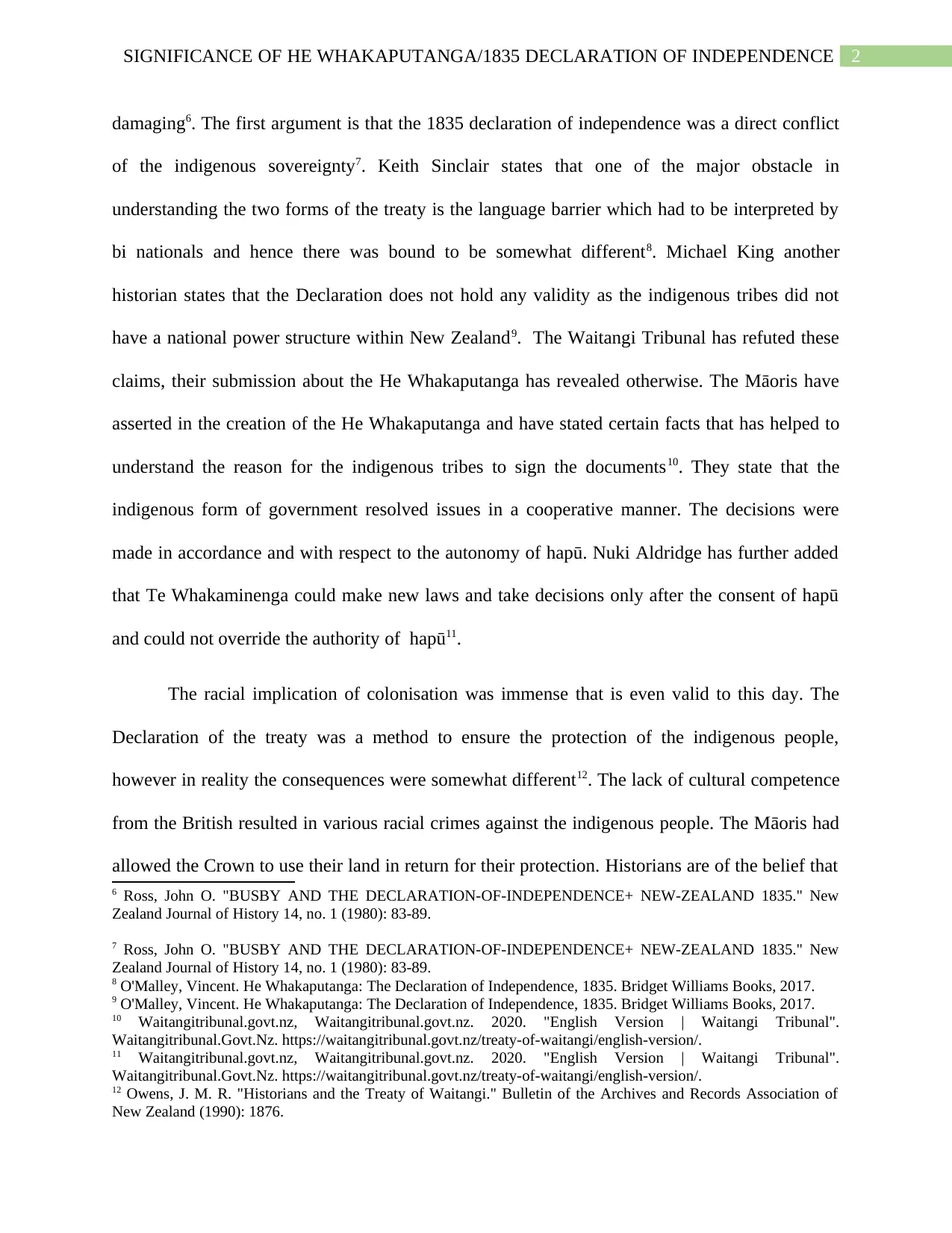
2SIGNIFICANCE OF HE WHAKAPUTANGA/1835 DECLARATION OF INDEPENDENCE
damaging6. The first argument is that the 1835 declaration of independence was a direct conflict
of the indigenous sovereignty7. Keith Sinclair states that one of the major obstacle in
understanding the two forms of the treaty is the language barrier which had to be interpreted by
bi nationals and hence there was bound to be somewhat different8. Michael King another
historian states that the Declaration does not hold any validity as the indigenous tribes did not
have a national power structure within New Zealand9. The Waitangi Tribunal has refuted these
claims, their submission about the He Whakaputanga has revealed otherwise. The Māoris have
asserted in the creation of the He Whakaputanga and have stated certain facts that has helped to
understand the reason for the indigenous tribes to sign the documents10. They state that the
indigenous form of government resolved issues in a cooperative manner. The decisions were
made in accordance and with respect to the autonomy of hapū. Nuki Aldridge has further added
that Te Whakaminenga could make new laws and take decisions only after the consent of hapū
and could not override the authority of hapū11.
The racial implication of colonisation was immense that is even valid to this day. The
Declaration of the treaty was a method to ensure the protection of the indigenous people,
however in reality the consequences were somewhat different12. The lack of cultural competence
from the British resulted in various racial crimes against the indigenous people. The Māoris had
allowed the Crown to use their land in return for their protection. Historians are of the belief that
6 Ross, John O. "BUSBY AND THE DECLARATION-OF-INDEPENDENCE+ NEW-ZEALAND 1835." New
Zealand Journal of History 14, no. 1 (1980): 83-89.
7 Ross, John O. "BUSBY AND THE DECLARATION-OF-INDEPENDENCE+ NEW-ZEALAND 1835." New
Zealand Journal of History 14, no. 1 (1980): 83-89.
8 O'Malley, Vincent. He Whakaputanga: The Declaration of Independence, 1835. Bridget Williams Books, 2017.
9 O'Malley, Vincent. He Whakaputanga: The Declaration of Independence, 1835. Bridget Williams Books, 2017.
10 Waitangitribunal.govt.nz, Waitangitribunal.govt.nz. 2020. "English Version | Waitangi Tribunal".
Waitangitribunal.Govt.Nz. https://waitangitribunal.govt.nz/treaty-of-waitangi/english-version/.
11 Waitangitribunal.govt.nz, Waitangitribunal.govt.nz. 2020. "English Version | Waitangi Tribunal".
Waitangitribunal.Govt.Nz. https://waitangitribunal.govt.nz/treaty-of-waitangi/english-version/.
12 Owens, J. M. R. "Historians and the Treaty of Waitangi." Bulletin of the Archives and Records Association of
New Zealand (1990): 1876.
damaging6. The first argument is that the 1835 declaration of independence was a direct conflict
of the indigenous sovereignty7. Keith Sinclair states that one of the major obstacle in
understanding the two forms of the treaty is the language barrier which had to be interpreted by
bi nationals and hence there was bound to be somewhat different8. Michael King another
historian states that the Declaration does not hold any validity as the indigenous tribes did not
have a national power structure within New Zealand9. The Waitangi Tribunal has refuted these
claims, their submission about the He Whakaputanga has revealed otherwise. The Māoris have
asserted in the creation of the He Whakaputanga and have stated certain facts that has helped to
understand the reason for the indigenous tribes to sign the documents10. They state that the
indigenous form of government resolved issues in a cooperative manner. The decisions were
made in accordance and with respect to the autonomy of hapū. Nuki Aldridge has further added
that Te Whakaminenga could make new laws and take decisions only after the consent of hapū
and could not override the authority of hapū11.
The racial implication of colonisation was immense that is even valid to this day. The
Declaration of the treaty was a method to ensure the protection of the indigenous people,
however in reality the consequences were somewhat different12. The lack of cultural competence
from the British resulted in various racial crimes against the indigenous people. The Māoris had
allowed the Crown to use their land in return for their protection. Historians are of the belief that
6 Ross, John O. "BUSBY AND THE DECLARATION-OF-INDEPENDENCE+ NEW-ZEALAND 1835." New
Zealand Journal of History 14, no. 1 (1980): 83-89.
7 Ross, John O. "BUSBY AND THE DECLARATION-OF-INDEPENDENCE+ NEW-ZEALAND 1835." New
Zealand Journal of History 14, no. 1 (1980): 83-89.
8 O'Malley, Vincent. He Whakaputanga: The Declaration of Independence, 1835. Bridget Williams Books, 2017.
9 O'Malley, Vincent. He Whakaputanga: The Declaration of Independence, 1835. Bridget Williams Books, 2017.
10 Waitangitribunal.govt.nz, Waitangitribunal.govt.nz. 2020. "English Version | Waitangi Tribunal".
Waitangitribunal.Govt.Nz. https://waitangitribunal.govt.nz/treaty-of-waitangi/english-version/.
11 Waitangitribunal.govt.nz, Waitangitribunal.govt.nz. 2020. "English Version | Waitangi Tribunal".
Waitangitribunal.Govt.Nz. https://waitangitribunal.govt.nz/treaty-of-waitangi/english-version/.
12 Owens, J. M. R. "Historians and the Treaty of Waitangi." Bulletin of the Archives and Records Association of
New Zealand (1990): 1876.
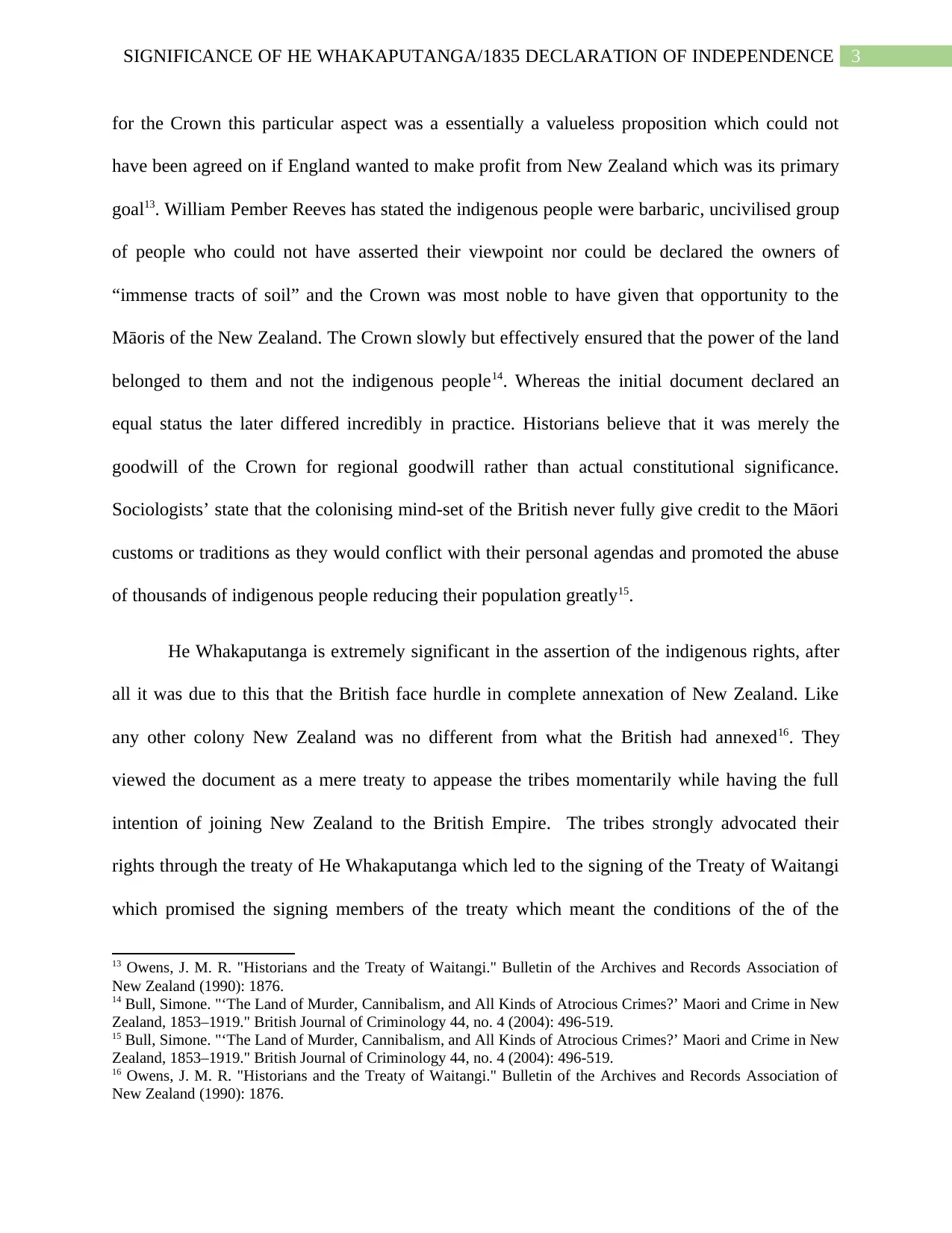
3SIGNIFICANCE OF HE WHAKAPUTANGA/1835 DECLARATION OF INDEPENDENCE
for the Crown this particular aspect was a essentially a valueless proposition which could not
have been agreed on if England wanted to make profit from New Zealand which was its primary
goal13. William Pember Reeves has stated the indigenous people were barbaric, uncivilised group
of people who could not have asserted their viewpoint nor could be declared the owners of
“immense tracts of soil” and the Crown was most noble to have given that opportunity to the
Māoris of the New Zealand. The Crown slowly but effectively ensured that the power of the land
belonged to them and not the indigenous people14. Whereas the initial document declared an
equal status the later differed incredibly in practice. Historians believe that it was merely the
goodwill of the Crown for regional goodwill rather than actual constitutional significance.
Sociologists’ state that the colonising mind-set of the British never fully give credit to the Māori
customs or traditions as they would conflict with their personal agendas and promoted the abuse
of thousands of indigenous people reducing their population greatly15.
He Whakaputanga is extremely significant in the assertion of the indigenous rights, after
all it was due to this that the British face hurdle in complete annexation of New Zealand. Like
any other colony New Zealand was no different from what the British had annexed16. They
viewed the document as a mere treaty to appease the tribes momentarily while having the full
intention of joining New Zealand to the British Empire. The tribes strongly advocated their
rights through the treaty of He Whakaputanga which led to the signing of the Treaty of Waitangi
which promised the signing members of the treaty which meant the conditions of the of the
13 Owens, J. M. R. "Historians and the Treaty of Waitangi." Bulletin of the Archives and Records Association of
New Zealand (1990): 1876.
14 Bull, Simone. "‘The Land of Murder, Cannibalism, and All Kinds of Atrocious Crimes?’ Maori and Crime in New
Zealand, 1853–1919." British Journal of Criminology 44, no. 4 (2004): 496-519.
15 Bull, Simone. "‘The Land of Murder, Cannibalism, and All Kinds of Atrocious Crimes?’ Maori and Crime in New
Zealand, 1853–1919." British Journal of Criminology 44, no. 4 (2004): 496-519.
16 Owens, J. M. R. "Historians and the Treaty of Waitangi." Bulletin of the Archives and Records Association of
New Zealand (1990): 1876.
for the Crown this particular aspect was a essentially a valueless proposition which could not
have been agreed on if England wanted to make profit from New Zealand which was its primary
goal13. William Pember Reeves has stated the indigenous people were barbaric, uncivilised group
of people who could not have asserted their viewpoint nor could be declared the owners of
“immense tracts of soil” and the Crown was most noble to have given that opportunity to the
Māoris of the New Zealand. The Crown slowly but effectively ensured that the power of the land
belonged to them and not the indigenous people14. Whereas the initial document declared an
equal status the later differed incredibly in practice. Historians believe that it was merely the
goodwill of the Crown for regional goodwill rather than actual constitutional significance.
Sociologists’ state that the colonising mind-set of the British never fully give credit to the Māori
customs or traditions as they would conflict with their personal agendas and promoted the abuse
of thousands of indigenous people reducing their population greatly15.
He Whakaputanga is extremely significant in the assertion of the indigenous rights, after
all it was due to this that the British face hurdle in complete annexation of New Zealand. Like
any other colony New Zealand was no different from what the British had annexed16. They
viewed the document as a mere treaty to appease the tribes momentarily while having the full
intention of joining New Zealand to the British Empire. The tribes strongly advocated their
rights through the treaty of He Whakaputanga which led to the signing of the Treaty of Waitangi
which promised the signing members of the treaty which meant the conditions of the of the
13 Owens, J. M. R. "Historians and the Treaty of Waitangi." Bulletin of the Archives and Records Association of
New Zealand (1990): 1876.
14 Bull, Simone. "‘The Land of Murder, Cannibalism, and All Kinds of Atrocious Crimes?’ Maori and Crime in New
Zealand, 1853–1919." British Journal of Criminology 44, no. 4 (2004): 496-519.
15 Bull, Simone. "‘The Land of Murder, Cannibalism, and All Kinds of Atrocious Crimes?’ Maori and Crime in New
Zealand, 1853–1919." British Journal of Criminology 44, no. 4 (2004): 496-519.
16 Owens, J. M. R. "Historians and the Treaty of Waitangi." Bulletin of the Archives and Records Association of
New Zealand (1990): 1876.
Secure Best Marks with AI Grader
Need help grading? Try our AI Grader for instant feedback on your assignments.
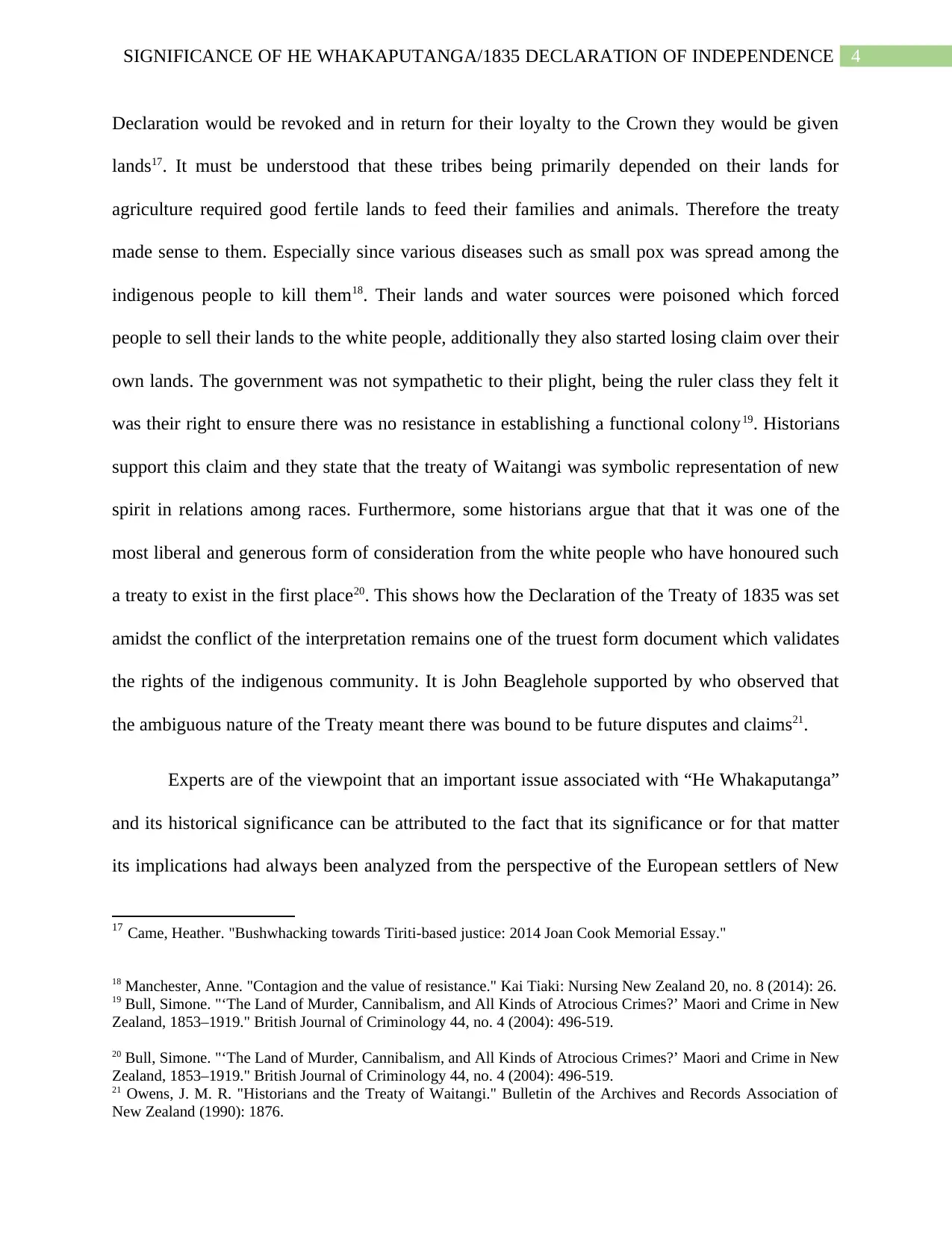
4SIGNIFICANCE OF HE WHAKAPUTANGA/1835 DECLARATION OF INDEPENDENCE
Declaration would be revoked and in return for their loyalty to the Crown they would be given
lands17. It must be understood that these tribes being primarily depended on their lands for
agriculture required good fertile lands to feed their families and animals. Therefore the treaty
made sense to them. Especially since various diseases such as small pox was spread among the
indigenous people to kill them18. Their lands and water sources were poisoned which forced
people to sell their lands to the white people, additionally they also started losing claim over their
own lands. The government was not sympathetic to their plight, being the ruler class they felt it
was their right to ensure there was no resistance in establishing a functional colony19. Historians
support this claim and they state that the treaty of Waitangi was symbolic representation of new
spirit in relations among races. Furthermore, some historians argue that that it was one of the
most liberal and generous form of consideration from the white people who have honoured such
a treaty to exist in the first place20. This shows how the Declaration of the Treaty of 1835 was set
amidst the conflict of the interpretation remains one of the truest form document which validates
the rights of the indigenous community. It is John Beaglehole supported by who observed that
the ambiguous nature of the Treaty meant there was bound to be future disputes and claims21.
Experts are of the viewpoint that an important issue associated with “He Whakaputanga”
and its historical significance can be attributed to the fact that its significance or for that matter
its implications had always been analyzed from the perspective of the European settlers of New
17 Came, Heather. "Bushwhacking towards Tiriti-based justice: 2014 Joan Cook Memorial Essay."
18 Manchester, Anne. "Contagion and the value of resistance." Kai Tiaki: Nursing New Zealand 20, no. 8 (2014): 26.
19 Bull, Simone. "‘The Land of Murder, Cannibalism, and All Kinds of Atrocious Crimes?’ Maori and Crime in New
Zealand, 1853–1919." British Journal of Criminology 44, no. 4 (2004): 496-519.
20 Bull, Simone. "‘The Land of Murder, Cannibalism, and All Kinds of Atrocious Crimes?’ Maori and Crime in New
Zealand, 1853–1919." British Journal of Criminology 44, no. 4 (2004): 496-519.
21 Owens, J. M. R. "Historians and the Treaty of Waitangi." Bulletin of the Archives and Records Association of
New Zealand (1990): 1876.
Declaration would be revoked and in return for their loyalty to the Crown they would be given
lands17. It must be understood that these tribes being primarily depended on their lands for
agriculture required good fertile lands to feed their families and animals. Therefore the treaty
made sense to them. Especially since various diseases such as small pox was spread among the
indigenous people to kill them18. Their lands and water sources were poisoned which forced
people to sell their lands to the white people, additionally they also started losing claim over their
own lands. The government was not sympathetic to their plight, being the ruler class they felt it
was their right to ensure there was no resistance in establishing a functional colony19. Historians
support this claim and they state that the treaty of Waitangi was symbolic representation of new
spirit in relations among races. Furthermore, some historians argue that that it was one of the
most liberal and generous form of consideration from the white people who have honoured such
a treaty to exist in the first place20. This shows how the Declaration of the Treaty of 1835 was set
amidst the conflict of the interpretation remains one of the truest form document which validates
the rights of the indigenous community. It is John Beaglehole supported by who observed that
the ambiguous nature of the Treaty meant there was bound to be future disputes and claims21.
Experts are of the viewpoint that an important issue associated with “He Whakaputanga”
and its historical significance can be attributed to the fact that its significance or for that matter
its implications had always been analyzed from the perspective of the European settlers of New
17 Came, Heather. "Bushwhacking towards Tiriti-based justice: 2014 Joan Cook Memorial Essay."
18 Manchester, Anne. "Contagion and the value of resistance." Kai Tiaki: Nursing New Zealand 20, no. 8 (2014): 26.
19 Bull, Simone. "‘The Land of Murder, Cannibalism, and All Kinds of Atrocious Crimes?’ Maori and Crime in New
Zealand, 1853–1919." British Journal of Criminology 44, no. 4 (2004): 496-519.
20 Bull, Simone. "‘The Land of Murder, Cannibalism, and All Kinds of Atrocious Crimes?’ Maori and Crime in New
Zealand, 1853–1919." British Journal of Criminology 44, no. 4 (2004): 496-519.
21 Owens, J. M. R. "Historians and the Treaty of Waitangi." Bulletin of the Archives and Records Association of
New Zealand (1990): 1876.
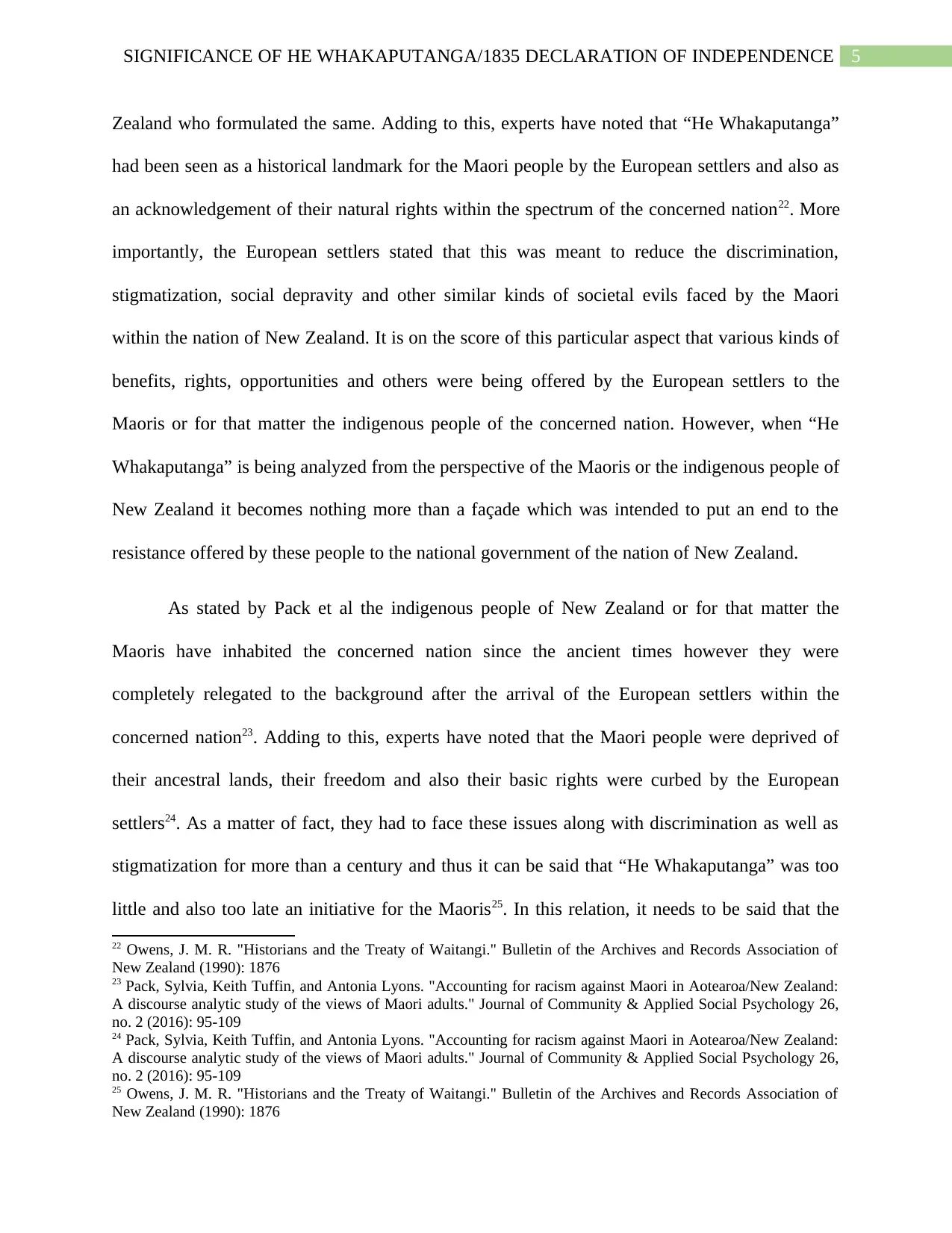
5SIGNIFICANCE OF HE WHAKAPUTANGA/1835 DECLARATION OF INDEPENDENCE
Zealand who formulated the same. Adding to this, experts have noted that “He Whakaputanga”
had been seen as a historical landmark for the Maori people by the European settlers and also as
an acknowledgement of their natural rights within the spectrum of the concerned nation22. More
importantly, the European settlers stated that this was meant to reduce the discrimination,
stigmatization, social depravity and other similar kinds of societal evils faced by the Maori
within the nation of New Zealand. It is on the score of this particular aspect that various kinds of
benefits, rights, opportunities and others were being offered by the European settlers to the
Maoris or for that matter the indigenous people of the concerned nation. However, when “He
Whakaputanga” is being analyzed from the perspective of the Maoris or the indigenous people of
New Zealand it becomes nothing more than a façade which was intended to put an end to the
resistance offered by these people to the national government of the nation of New Zealand.
As stated by Pack et al the indigenous people of New Zealand or for that matter the
Maoris have inhabited the concerned nation since the ancient times however they were
completely relegated to the background after the arrival of the European settlers within the
concerned nation23. Adding to this, experts have noted that the Maori people were deprived of
their ancestral lands, their freedom and also their basic rights were curbed by the European
settlers24. As a matter of fact, they had to face these issues along with discrimination as well as
stigmatization for more than a century and thus it can be said that “He Whakaputanga” was too
little and also too late an initiative for the Maoris25. In this relation, it needs to be said that the
22 Owens, J. M. R. "Historians and the Treaty of Waitangi." Bulletin of the Archives and Records Association of
New Zealand (1990): 1876
23 Pack, Sylvia, Keith Tuffin, and Antonia Lyons. "Accounting for racism against Maori in Aotearoa/New Zealand:
A discourse analytic study of the views of Maori adults." Journal of Community & Applied Social Psychology 26,
no. 2 (2016): 95-109
24 Pack, Sylvia, Keith Tuffin, and Antonia Lyons. "Accounting for racism against Maori in Aotearoa/New Zealand:
A discourse analytic study of the views of Maori adults." Journal of Community & Applied Social Psychology 26,
no. 2 (2016): 95-109
25 Owens, J. M. R. "Historians and the Treaty of Waitangi." Bulletin of the Archives and Records Association of
New Zealand (1990): 1876
Zealand who formulated the same. Adding to this, experts have noted that “He Whakaputanga”
had been seen as a historical landmark for the Maori people by the European settlers and also as
an acknowledgement of their natural rights within the spectrum of the concerned nation22. More
importantly, the European settlers stated that this was meant to reduce the discrimination,
stigmatization, social depravity and other similar kinds of societal evils faced by the Maori
within the nation of New Zealand. It is on the score of this particular aspect that various kinds of
benefits, rights, opportunities and others were being offered by the European settlers to the
Maoris or for that matter the indigenous people of the concerned nation. However, when “He
Whakaputanga” is being analyzed from the perspective of the Maoris or the indigenous people of
New Zealand it becomes nothing more than a façade which was intended to put an end to the
resistance offered by these people to the national government of the nation of New Zealand.
As stated by Pack et al the indigenous people of New Zealand or for that matter the
Maoris have inhabited the concerned nation since the ancient times however they were
completely relegated to the background after the arrival of the European settlers within the
concerned nation23. Adding to this, experts have noted that the Maori people were deprived of
their ancestral lands, their freedom and also their basic rights were curbed by the European
settlers24. As a matter of fact, they had to face these issues along with discrimination as well as
stigmatization for more than a century and thus it can be said that “He Whakaputanga” was too
little and also too late an initiative for the Maoris25. In this relation, it needs to be said that the
22 Owens, J. M. R. "Historians and the Treaty of Waitangi." Bulletin of the Archives and Records Association of
New Zealand (1990): 1876
23 Pack, Sylvia, Keith Tuffin, and Antonia Lyons. "Accounting for racism against Maori in Aotearoa/New Zealand:
A discourse analytic study of the views of Maori adults." Journal of Community & Applied Social Psychology 26,
no. 2 (2016): 95-109
24 Pack, Sylvia, Keith Tuffin, and Antonia Lyons. "Accounting for racism against Maori in Aotearoa/New Zealand:
A discourse analytic study of the views of Maori adults." Journal of Community & Applied Social Psychology 26,
no. 2 (2016): 95-109
25 Owens, J. M. R. "Historians and the Treaty of Waitangi." Bulletin of the Archives and Records Association of
New Zealand (1990): 1876
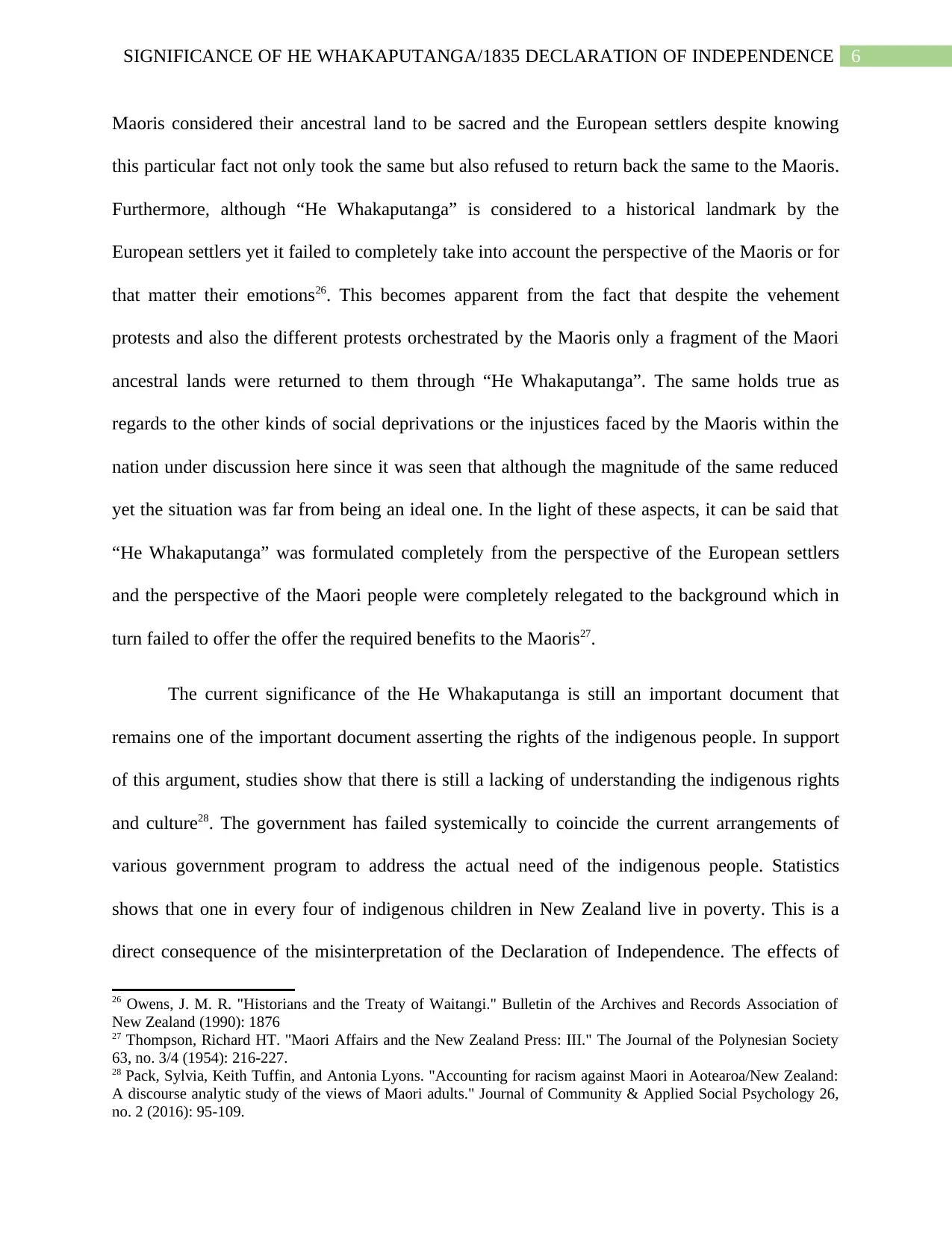
6SIGNIFICANCE OF HE WHAKAPUTANGA/1835 DECLARATION OF INDEPENDENCE
Maoris considered their ancestral land to be sacred and the European settlers despite knowing
this particular fact not only took the same but also refused to return back the same to the Maoris.
Furthermore, although “He Whakaputanga” is considered to a historical landmark by the
European settlers yet it failed to completely take into account the perspective of the Maoris or for
that matter their emotions26. This becomes apparent from the fact that despite the vehement
protests and also the different protests orchestrated by the Maoris only a fragment of the Maori
ancestral lands were returned to them through “He Whakaputanga”. The same holds true as
regards to the other kinds of social deprivations or the injustices faced by the Maoris within the
nation under discussion here since it was seen that although the magnitude of the same reduced
yet the situation was far from being an ideal one. In the light of these aspects, it can be said that
“He Whakaputanga” was formulated completely from the perspective of the European settlers
and the perspective of the Maori people were completely relegated to the background which in
turn failed to offer the offer the required benefits to the Maoris27.
The current significance of the He Whakaputanga is still an important document that
remains one of the important document asserting the rights of the indigenous people. In support
of this argument, studies show that there is still a lacking of understanding the indigenous rights
and culture28. The government has failed systemically to coincide the current arrangements of
various government program to address the actual need of the indigenous people. Statistics
shows that one in every four of indigenous children in New Zealand live in poverty. This is a
direct consequence of the misinterpretation of the Declaration of Independence. The effects of
26 Owens, J. M. R. "Historians and the Treaty of Waitangi." Bulletin of the Archives and Records Association of
New Zealand (1990): 1876
27 Thompson, Richard HT. "Maori Affairs and the New Zealand Press: III." The Journal of the Polynesian Society
63, no. 3/4 (1954): 216-227.
28 Pack, Sylvia, Keith Tuffin, and Antonia Lyons. "Accounting for racism against Maori in Aotearoa/New Zealand:
A discourse analytic study of the views of Maori adults." Journal of Community & Applied Social Psychology 26,
no. 2 (2016): 95-109.
Maoris considered their ancestral land to be sacred and the European settlers despite knowing
this particular fact not only took the same but also refused to return back the same to the Maoris.
Furthermore, although “He Whakaputanga” is considered to a historical landmark by the
European settlers yet it failed to completely take into account the perspective of the Maoris or for
that matter their emotions26. This becomes apparent from the fact that despite the vehement
protests and also the different protests orchestrated by the Maoris only a fragment of the Maori
ancestral lands were returned to them through “He Whakaputanga”. The same holds true as
regards to the other kinds of social deprivations or the injustices faced by the Maoris within the
nation under discussion here since it was seen that although the magnitude of the same reduced
yet the situation was far from being an ideal one. In the light of these aspects, it can be said that
“He Whakaputanga” was formulated completely from the perspective of the European settlers
and the perspective of the Maori people were completely relegated to the background which in
turn failed to offer the offer the required benefits to the Maoris27.
The current significance of the He Whakaputanga is still an important document that
remains one of the important document asserting the rights of the indigenous people. In support
of this argument, studies show that there is still a lacking of understanding the indigenous rights
and culture28. The government has failed systemically to coincide the current arrangements of
various government program to address the actual need of the indigenous people. Statistics
shows that one in every four of indigenous children in New Zealand live in poverty. This is a
direct consequence of the misinterpretation of the Declaration of Independence. The effects of
26 Owens, J. M. R. "Historians and the Treaty of Waitangi." Bulletin of the Archives and Records Association of
New Zealand (1990): 1876
27 Thompson, Richard HT. "Maori Affairs and the New Zealand Press: III." The Journal of the Polynesian Society
63, no. 3/4 (1954): 216-227.
28 Pack, Sylvia, Keith Tuffin, and Antonia Lyons. "Accounting for racism against Maori in Aotearoa/New Zealand:
A discourse analytic study of the views of Maori adults." Journal of Community & Applied Social Psychology 26,
no. 2 (2016): 95-109.
Paraphrase This Document
Need a fresh take? Get an instant paraphrase of this document with our AI Paraphraser
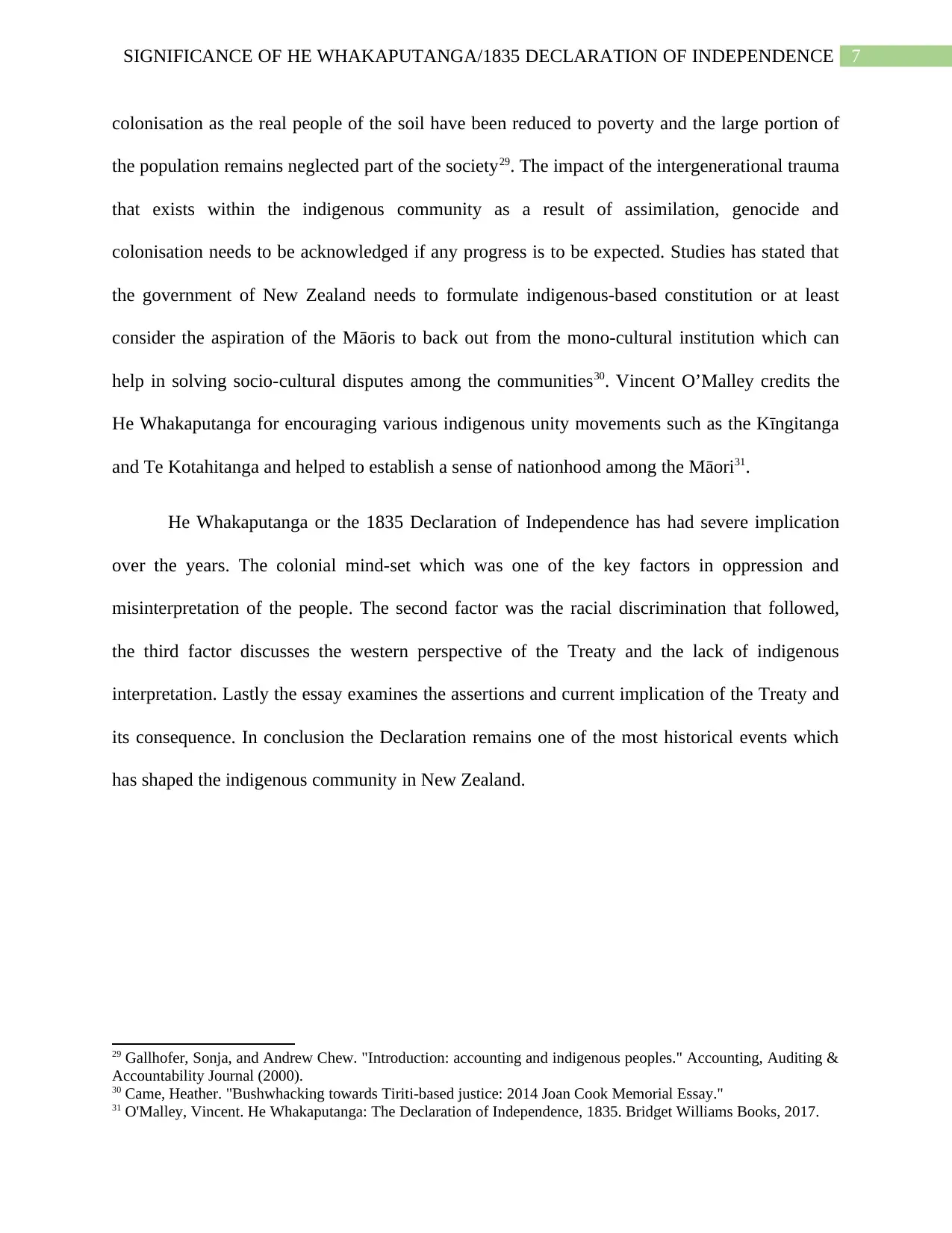
7SIGNIFICANCE OF HE WHAKAPUTANGA/1835 DECLARATION OF INDEPENDENCE
colonisation as the real people of the soil have been reduced to poverty and the large portion of
the population remains neglected part of the society29. The impact of the intergenerational trauma
that exists within the indigenous community as a result of assimilation, genocide and
colonisation needs to be acknowledged if any progress is to be expected. Studies has stated that
the government of New Zealand needs to formulate indigenous-based constitution or at least
consider the aspiration of the Māoris to back out from the mono-cultural institution which can
help in solving socio-cultural disputes among the communities30. Vincent O’Malley credits the
He Whakaputanga for encouraging various indigenous unity movements such as the Kīngitanga
and Te Kotahitanga and helped to establish a sense of nationhood among the Māori31.
He Whakaputanga or the 1835 Declaration of Independence has had severe implication
over the years. The colonial mind-set which was one of the key factors in oppression and
misinterpretation of the people. The second factor was the racial discrimination that followed,
the third factor discusses the western perspective of the Treaty and the lack of indigenous
interpretation. Lastly the essay examines the assertions and current implication of the Treaty and
its consequence. In conclusion the Declaration remains one of the most historical events which
has shaped the indigenous community in New Zealand.
29 Gallhofer, Sonja, and Andrew Chew. "Introduction: accounting and indigenous peoples." Accounting, Auditing &
Accountability Journal (2000).
30 Came, Heather. "Bushwhacking towards Tiriti-based justice: 2014 Joan Cook Memorial Essay."
31 O'Malley, Vincent. He Whakaputanga: The Declaration of Independence, 1835. Bridget Williams Books, 2017.
colonisation as the real people of the soil have been reduced to poverty and the large portion of
the population remains neglected part of the society29. The impact of the intergenerational trauma
that exists within the indigenous community as a result of assimilation, genocide and
colonisation needs to be acknowledged if any progress is to be expected. Studies has stated that
the government of New Zealand needs to formulate indigenous-based constitution or at least
consider the aspiration of the Māoris to back out from the mono-cultural institution which can
help in solving socio-cultural disputes among the communities30. Vincent O’Malley credits the
He Whakaputanga for encouraging various indigenous unity movements such as the Kīngitanga
and Te Kotahitanga and helped to establish a sense of nationhood among the Māori31.
He Whakaputanga or the 1835 Declaration of Independence has had severe implication
over the years. The colonial mind-set which was one of the key factors in oppression and
misinterpretation of the people. The second factor was the racial discrimination that followed,
the third factor discusses the western perspective of the Treaty and the lack of indigenous
interpretation. Lastly the essay examines the assertions and current implication of the Treaty and
its consequence. In conclusion the Declaration remains one of the most historical events which
has shaped the indigenous community in New Zealand.
29 Gallhofer, Sonja, and Andrew Chew. "Introduction: accounting and indigenous peoples." Accounting, Auditing &
Accountability Journal (2000).
30 Came, Heather. "Bushwhacking towards Tiriti-based justice: 2014 Joan Cook Memorial Essay."
31 O'Malley, Vincent. He Whakaputanga: The Declaration of Independence, 1835. Bridget Williams Books, 2017.
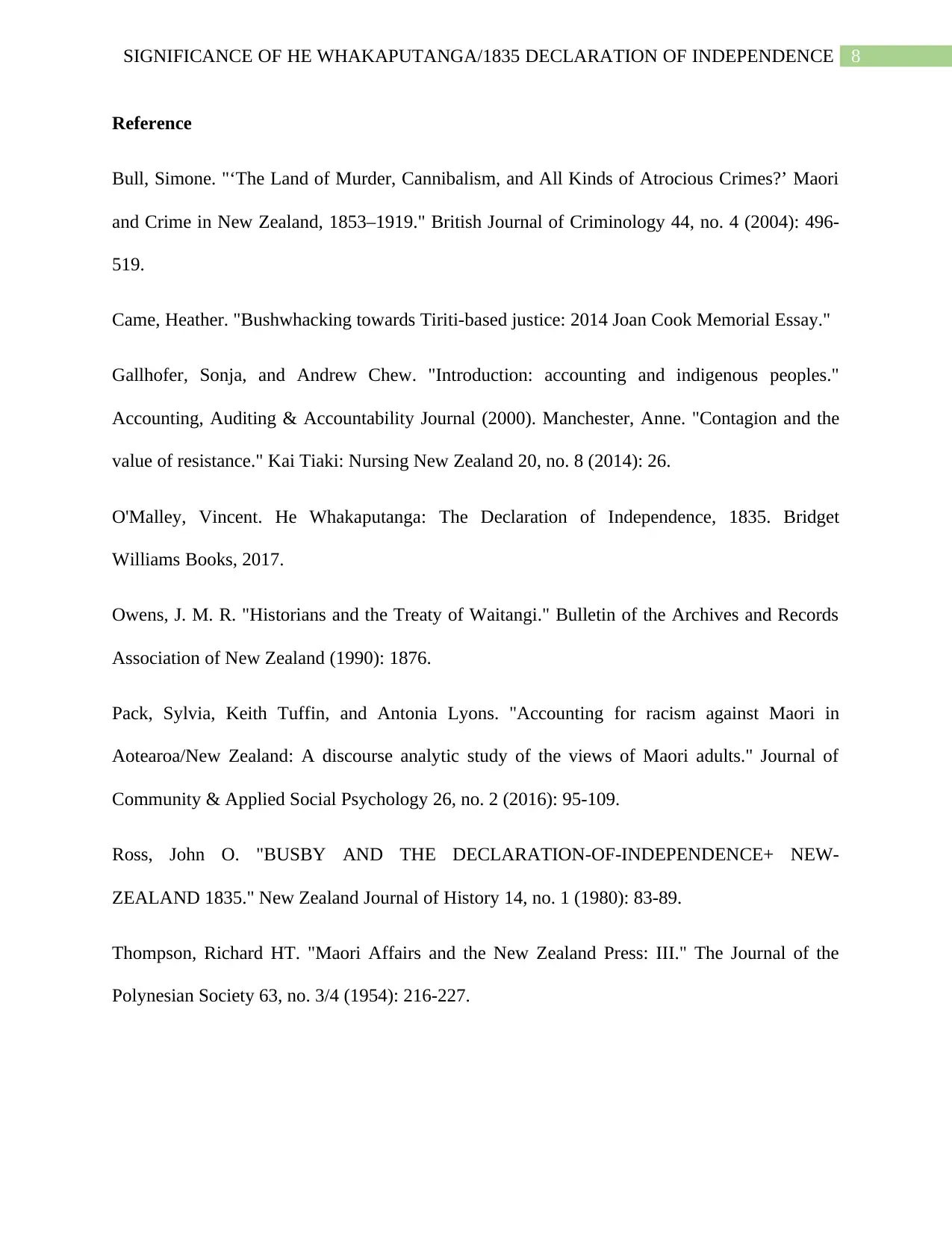
8SIGNIFICANCE OF HE WHAKAPUTANGA/1835 DECLARATION OF INDEPENDENCE
Reference
Bull, Simone. "‘The Land of Murder, Cannibalism, and All Kinds of Atrocious Crimes?’ Maori
and Crime in New Zealand, 1853–1919." British Journal of Criminology 44, no. 4 (2004): 496-
519.
Came, Heather. "Bushwhacking towards Tiriti-based justice: 2014 Joan Cook Memorial Essay."
Gallhofer, Sonja, and Andrew Chew. "Introduction: accounting and indigenous peoples."
Accounting, Auditing & Accountability Journal (2000). Manchester, Anne. "Contagion and the
value of resistance." Kai Tiaki: Nursing New Zealand 20, no. 8 (2014): 26.
O'Malley, Vincent. He Whakaputanga: The Declaration of Independence, 1835. Bridget
Williams Books, 2017.
Owens, J. M. R. "Historians and the Treaty of Waitangi." Bulletin of the Archives and Records
Association of New Zealand (1990): 1876.
Pack, Sylvia, Keith Tuffin, and Antonia Lyons. "Accounting for racism against Maori in
Aotearoa/New Zealand: A discourse analytic study of the views of Maori adults." Journal of
Community & Applied Social Psychology 26, no. 2 (2016): 95-109.
Ross, John O. "BUSBY AND THE DECLARATION-OF-INDEPENDENCE+ NEW-
ZEALAND 1835." New Zealand Journal of History 14, no. 1 (1980): 83-89.
Thompson, Richard HT. "Maori Affairs and the New Zealand Press: III." The Journal of the
Polynesian Society 63, no. 3/4 (1954): 216-227.
Reference
Bull, Simone. "‘The Land of Murder, Cannibalism, and All Kinds of Atrocious Crimes?’ Maori
and Crime in New Zealand, 1853–1919." British Journal of Criminology 44, no. 4 (2004): 496-
519.
Came, Heather. "Bushwhacking towards Tiriti-based justice: 2014 Joan Cook Memorial Essay."
Gallhofer, Sonja, and Andrew Chew. "Introduction: accounting and indigenous peoples."
Accounting, Auditing & Accountability Journal (2000). Manchester, Anne. "Contagion and the
value of resistance." Kai Tiaki: Nursing New Zealand 20, no. 8 (2014): 26.
O'Malley, Vincent. He Whakaputanga: The Declaration of Independence, 1835. Bridget
Williams Books, 2017.
Owens, J. M. R. "Historians and the Treaty of Waitangi." Bulletin of the Archives and Records
Association of New Zealand (1990): 1876.
Pack, Sylvia, Keith Tuffin, and Antonia Lyons. "Accounting for racism against Maori in
Aotearoa/New Zealand: A discourse analytic study of the views of Maori adults." Journal of
Community & Applied Social Psychology 26, no. 2 (2016): 95-109.
Ross, John O. "BUSBY AND THE DECLARATION-OF-INDEPENDENCE+ NEW-
ZEALAND 1835." New Zealand Journal of History 14, no. 1 (1980): 83-89.
Thompson, Richard HT. "Maori Affairs and the New Zealand Press: III." The Journal of the
Polynesian Society 63, no. 3/4 (1954): 216-227.
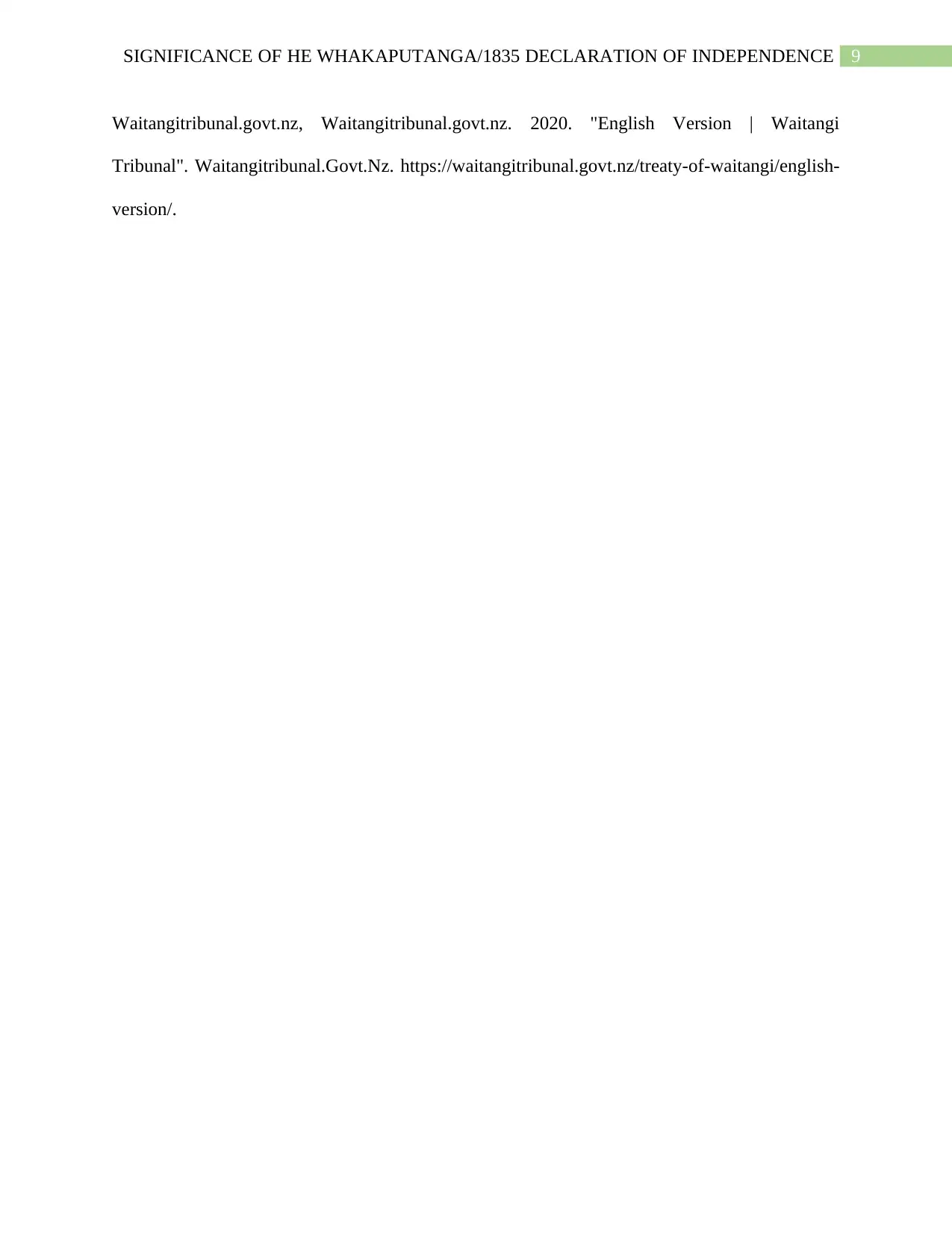
9SIGNIFICANCE OF HE WHAKAPUTANGA/1835 DECLARATION OF INDEPENDENCE
Waitangitribunal.govt.nz, Waitangitribunal.govt.nz. 2020. "English Version | Waitangi
Tribunal". Waitangitribunal.Govt.Nz. https://waitangitribunal.govt.nz/treaty-of-waitangi/english-
version/.
Waitangitribunal.govt.nz, Waitangitribunal.govt.nz. 2020. "English Version | Waitangi
Tribunal". Waitangitribunal.Govt.Nz. https://waitangitribunal.govt.nz/treaty-of-waitangi/english-
version/.
1 out of 10
Related Documents
Your All-in-One AI-Powered Toolkit for Academic Success.
+13062052269
info@desklib.com
Available 24*7 on WhatsApp / Email
![[object Object]](/_next/static/media/star-bottom.7253800d.svg)
Unlock your academic potential
© 2024 | Zucol Services PVT LTD | All rights reserved.





